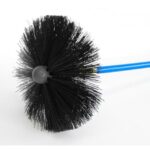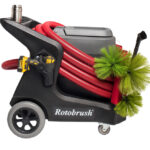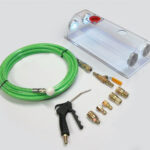Comparison Guide


Comparing Duct Cleaning Methods
Understand the various approaches professionals use for duct cleaning. Learn about each method’s advantages and limitations, and how they impact indoor air quality.
Brush Cleaning
 This method involves physically brushing the inside of the ducts with a brush attached to a long rod, often manually. The loosened debris is then vacuumed out using a high-powered vacuum.
This method involves physically brushing the inside of the ducts with a brush attached to a long rod, often manually. The loosened debris is then vacuumed out using a high-powered vacuum.
- Effectiveness: It can remove stubborn deposits and debris.
- Direct Contact: Ensures that all sides of the ductwork are contacted and cleaned.
- No chemicals: Doesn’t require any chemicals, so there's no risk of chemical residue.
- Labor Intensive: More time-consuming than some other methods.
- Potential Damage: If not done carefully, the brush can damage the duct's interior.
- Limited Reach: Might not be effective for long or winding duct systems.
Air Whip Cleaning (also known as "air snake" or "skipper ball" method)
 Uses compressed air to blast loose dirt and debris, which is then collected by a high-powered vacuum. The air whips or balls whip around in the duct, dislodging the debris.
Uses compressed air to blast loose dirt and debris, which is then collected by a high-powered vacuum. The air whips or balls whip around in the duct, dislodging the debris.
- Efficiency: Faster than manual brushing.
- Less Risk of Damage: No solid equipment physically rubbing against the duct interior.
- Reach: Good for longer duct systems where a brush might not reach effectively.
- Less Aggressive: Might not remove very stubborn deposits.
- Airborne Debris: If not properly vacuumed, this method can release more debris into the air.
Rotary Brush Cleaning
 A rotating brush, often motorized, is sent into the duct. As it spins, it loosens debris, which is then vacuumed out with a powerful vacuum system.
A rotating brush, often motorized, is sent into the duct. As it spins, it loosens debris, which is then vacuumed out with a powerful vacuum system.
- Efficiency: Faster than manual brushing.
- Less Risk of Damage: No solid equipment physically rubbing against the duct interior.
- Reach: Good for longer duct systems where a brush might not reach effectively.
- Less Aggressive: Might not remove very stubborn deposits.
- Airborne Debris: If not properly vacuumed, this method can release more debris into the air.
Rotobrush Cleaning
 A combination of a rotating brush and vacuum, the Rotobrush is designed for effective cleaning in residential and light commercial ducts. It’s ideal for shorter duct runs, easy to operate, but less suitable for complex or larger duct systems.
A combination of a rotating brush and vacuum, the Rotobrush is designed for effective cleaning in residential and light commercial ducts. It’s ideal for shorter duct runs, easy to operate, but less suitable for complex or larger duct systems.
- Combines rotary brushes with a built-in vacuum.
- Effective in residential and light commercial settings.
- Limited effectiveness in large or complex systems.
- Ideal for shorter ducts and less intensive cleaning.
RamAir Systems
 The RamAir System uses compressed air and a clear-view dome for duct cleaning, allowing real-time visual confirmation of the process. It’s versatile, less likely to cause duct damage, and often used alongside other cleaning methods.
The RamAir System uses compressed air and a clear-view dome for duct cleaning, allowing real-time visual confirmation of the process. It’s versatile, less likely to cause duct damage, and often used alongside other cleaning methods.
- Utilizes compressed air and a specialized clear-view dome for agitation and extraction.
- Allows visual confirmation of cleaning effectiveness.
- Suitable for various duct types, less risk of duct damage.
- Less Aggressive: Might not remove very stubborn deposits
- Airborned Debris: If not properly vacuumed, this method can release more debris into The air.
Shop Vac
 A basic, industrial-grade vacuum, the Shop Vac is used for removing loose debris in ducts, mostly in DIY or small-scale operations. Affordable and accessible, it’s less effective for thorough or heavy-duty duct cleaning tasks.
A basic, industrial-grade vacuum, the Shop Vac is used for removing loose debris in ducts, mostly in DIY or small-scale operations. Affordable and accessible, it’s less effective for thorough or heavy-duty duct cleaning tasks.
- Basic vacuum system for duct cleaning
- Less effective, primarily for loose debris.
- Accessible for DIY or smaller operations.
- Limited in scope and power, not suitable for heavy-duty jobs.
Which Method to Use for Different Duct Systems?
- Standard Residential Systems: Any of the three methods can be effective. It often depends on the technician's preference, homeowner's budget, and the specific condition of the ducts.
- Long, Winding, or Complex Systems: Rotary brush cleaning might be the most effective due to its combination of mechanical brushing and vacuuming.
- Ducts with Heavy Deposits: Brush cleaning can provide the needed agitation to dislodge stubborn debris.
- Regular Maintenance or Light Cleaning: Air whip cleaning can be a quicker and less invasive option.
Comparison Table:
| Method | Efficiency | Risk of Duct Damage | Chemical Use | Reach | Best For |
|---|---|---|---|---|---|
| Brush Cleaning | High | Higher | No | Limited | Heavy deposits in standard ducts |
| Air Whip Cleaning | High | Lower | No | Good | Quick cleaning, longer ducts |
| Rotary Brush Cleaning | High | Lower | No | Good | Longer, complex systems |
| Rotobrush Cleaning | Moderate | Moderate | No | Limited | Shorter ducts, residential settings |
| RamAir Systems | High | Low | No | Good | Various duct types, visual confirmation |
| Shop Vac | Low | Moderate | No | Very limited | Loose debris, DIY, smaller operations |
Conclusion:
The best method often depends on the specific needs of the duct system and the goals of the cleaning. Homeowners and building managers should discuss with professional duct cleaning services to determine the most suitable approach for their needs. Regular maintenance and periodic inspections are also key to ensuring a healthy indoor air environment.
frequently asked questions
What are the primary differences between brush cleaning, air whip cleaning, and rotary brush cleaning methods for duct cleaning?
Brush cleaning involves physically brushing the ducts with a brush attached to a rod, air whip cleaning uses compressed air to dislodge debris, and rotary brush cleaning employs a motorized rotating brush to agitate and vacuum out debris.
Which method is most effective at removing stubborn debris and contaminants from ducts?
Brush cleaning is known for its effectiveness in removing stubborn deposits and debris from the ducts.
Are there any risks associated with brush cleaning, such as potential damage to the ductwork?
Yes, if not done carefully, brush cleaning can potentially damage the interior of the ducts.
Which method is recommended for duct systems with many bends and turns?
Rotary brush cleaning is often recommended for duct systems with complex layouts due to its flexibility and ability to reach various angles.
What is the advantage of air whip cleaning for longer duct systems?
Air whip cleaning is efficient for longer duct systems where manual brushing might not effectively reach, dislodging debris with the force of compressed air.
Does air whip cleaning release more debris into the air compared to other methods?
If not properly vacuumed, air whip cleaning can potentially release more debris into the air, so proper vacuuming is essential.
Are any of these methods harmful to indoor air quality due to chemical residues?
None of these methods involve the use of chemicals, so there's no risk of chemical residues affecting indoor air quality.
Which method is suitable for regular maintenance or light cleaning of ducts?
Air whip cleaning is often chosen for regular maintenance or light cleaning due to its quick and less invasive nature.
What should homeowners consider when deciding which method to use for their duct cleaning?
Homeowners should consider factors such as the condition of their ducts, the complexity of the system, their budget, and consult with professional duct cleaning services to determine the most suitable method.
Is regular maintenance and periodic inspections important for maintaining healthy indoor air quality?
Yes, regular maintenance and periodic inspections are crucial for ensuring a healthy indoor air environment and prolonging the effectiveness of duct cleaning efforts.


 NADCA
NADCA 

